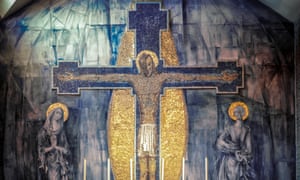 An outstanding mosaic of the crucifixion, created by a notable Jewish
artist who fled from Nazi persecution, is in danger of being lost
because the Roman Catholic church where it is displayed has been
earmarked for closure.
An outstanding mosaic of the crucifixion, created by a notable Jewish
artist who fled from Nazi persecution, is in danger of being lost
because the Roman Catholic church where it is displayed has been
earmarked for closure.Georg Mayer-Marton, who was a leading figure in Vienna’s artistic world between the wars, fled Austria after the Anschluss and moved to Britain.
Most of his life’s work was destroyed by a bomb during the London blitz after he had settled in the capital as a refugee. He later became the foremost postwar creator of Byzantine mosaics in Britain.
Now,as part of a series of church closures across the north-west, one of his most important works, a mosaic of the crucifixion, is at risk following the decision by the Roman Catholic diocese of Salford to shut the Holy Rosary church where it is installed.
The arts heritage body, the Public Monuments and Sculpture Association, has warned the bishop, the Right Rev John Arnold, that the mosaic’s destruction would be “a very regrettable loss, if not an act of iconoclasm”.
According to the association’s chairman, John Lewis, the émigré artists of postwar Britain, of whom Mayer-Marton was a leading figure, are only now being appreciated by art historians.
In a letter to Arnold, Lewis cited the Oldham mosaic as “an unusual commission … which must be preserved. Mayer-Marton’s work in churches during this period has considerable historic and religious significance.”
The eight-metre-high mosaic was installed in the church in the 1950s and is made of natural stone and glass tesserae, giving it a striking sheen, typical of Byzantine work.
The original piece had frescoes depicting St John to Jesus’s left and his mother Mary to his right, but these were covered over with white emulsion in 1980.
Mayer-Marton was a Hungarian Jew, born in 1897, who served in the Austrian army during the first world war before studying art in Vienna, a city with a vibrant art scene of which Gustav Klimt was a part.
As well as being inspired by expressionism and modernism, he also studied in Ravenna, the Italian city famed for its Byzantine mosaics, before returning to Vienna.
In 1952 he moved to Liverpool to teach at the city’s art college, and it was at this time that he took up mosaic work in earnest and was commissioned by the Catholic church. One of his mosaics is installed in the Catholic Metropolitan Cathedral in Liverpool.
His great-nephew, Nick Braithwaite, who is campaigning to save the Oldham mosaic, said: “The mosaic is inspiring and beautiful and it dominates the church. It would be disastrous if it were lost, and would signal a dreadful failure to understand its unique value. We are urging the diocese to think again.
“My great-uncle, who was of Hungarian-Jewish descent, worked on this mosaic just 10 years after the war and losing his parents and brother in the Holocaust. It must have been very poignant for him to work on an image of the suffering Jesus.”
Among the art historians who have appealed to Arnold to save the mosaic is Professor Aaron Rosen, of King’s College London and author of Imagining Jewish Art. He said: “I regard it as a work of serious aesthetic and religious significance on a par with some of the strongest works of modern ecclesial art in Britain.”
According to Julian Treuherz, the former keeper of art galleries at National Museums Liverpool, Mayer-Marton’s mosaics are his most important works. “His mosaics, much larger in scale and more ambitious in content, are his most distinguished and powerful works,” he said.
Treuherz has urged the Catholic church to consider moving the work to another site if it proves impossible to keep the church open, which was done with the mosaic now in Liverpool’s Metropolitan Cathedral.
“This is a time-consuming and expensive process, but it is entirely feasible. However, it would be preferable to retain Mayer-Marton’s work in the setting for which it was designed,” he said.
The art world and Mayer-Marton’s family were alerted to the risk to the mosaic by Steve Haines, a former altar boy of Holy Rosary, whose mother still lives in the neighbourhood.
“The mosaic always caught my attention,” he said. “It captures the drama of the crucifixion. Mayer-Marton’s persecution by the Nazi regime and his perseverance is especially poignant and parishioners feel we owe it to him to protect his work.”
A decline in the numbers of both priests and parishioners prompted the plan to close the churches.
In a document about the closures, Arnold wrote: “Decisions about future structures cannot be limited to individual parishes but must encompass the whole diocese as a single church, in all its complexity and diversity of demands.
“I think it is important to remember that, in his ministry, Jesus never made any associations with buildings. His ministry was never tied to a particular place.”
More than 100 of 150 current parishes in the diocese will be amalgamated, with 22 churches closed.
Among the options being considered for them are demolition with the land used for social housing.
